Lazy Roast Beef: the very words conjure up images of a Sunday supper, effortless and delicious. Imagine sinking your teeth into tender, juicy slices of perfectly cooked roast beef, all without spending hours slaving away in the kitchen. Sounds too good to be true? It’s not! This recipe is all about maximizing flavor with minimal effort, making it the perfect centerpiece for a relaxed gathering or a satisfying weeknight meal.
Roast beef has a rich history, deeply rooted in British culinary tradition. It was often associated with celebrations and special occasions, a symbol of abundance and hospitality. Over time, variations of roast beef have spread across the globe, each region adding its own unique twist. But the core appeal remains the same: a hearty, flavorful, and satisfying dish that brings people together.
What makes this Lazy Roast Beef so irresistible? It’s the combination of melt-in-your-mouth tenderness, savory seasonings, and the sheer convenience of the cooking process. Forget complicated techniques and constant monitoring. This recipe utilizes a low and slow cooking method, allowing the beef to become incredibly tender and flavorful with minimal intervention. The result is a roast that’s both impressive and incredibly easy to prepare. The aroma alone will have your family and friends clamoring for a taste. So, let’s get started and discover the secret to perfectly cooked, effortlessly delicious roast beef!
Ingredients:
- 3-4 lb. Beef Chuck Roast
- 1 packet (1 oz) Dry Onion Soup Mix
- 1 packet (1 oz) Ranch Dressing Mix
- 1/2 cup Water
- 1 tbsp Olive Oil
- 1 tsp Garlic Powder
- 1/2 tsp Black Pepper
- Optional: Carrots, Potatoes, Celery (cut into large chunks)
Preparing the Roast:
- First, let’s get that roast ready! Take your beef chuck roast out of the refrigerator about 30 minutes before you plan to start cooking. This will help it cook more evenly. Pat it dry with paper towels. This is important because a dry surface will sear better.
- Now, in a small bowl, combine the dry onion soup mix, ranch dressing mix, garlic powder, and black pepper. Mix it all up really well. This is our flavor bomb!
- Drizzle the olive oil all over the chuck roast. Use your hands to rub it in, ensuring the entire surface is lightly coated. The olive oil helps the seasoning stick and promotes browning.
- Next, generously sprinkle the dry seasoning mixture all over the roast. Again, use your hands to rub it in, pressing it into the meat. Make sure every nook and cranny is covered. Don’t be shy! We want maximum flavor.
- If you’re using vegetables, now’s the time to prep them. Peel and chop your carrots, potatoes, and celery into large, roughly equal-sized chunks. We want them big enough to withstand the long cooking time without turning to mush.
Searing the Roast (Optional but Recommended):
While this recipe is called “Lazy Roast Beef,” searing the roast beforehand adds a depth of flavor that’s well worth the extra few minutes. If you’re *really* short on time, you can skip this step, but I highly recommend it!
- Heat a large, heavy-bottomed skillet or Dutch oven over medium-high heat. You want it nice and hot!
- Once the skillet is hot, carefully place the seasoned chuck roast in the skillet.
- Sear the roast for about 3-4 minutes per side, until it’s nicely browned. You’re not trying to cook it through, just develop a flavorful crust. Use tongs to turn the roast.
- Remove the roast from the skillet and set it aside.
- If you’re using vegetables and you seared the roast in a Dutch oven, leave any rendered fat in the pot. If you used a skillet, transfer the seared roast to the Dutch oven.
Slow Cooking in the Oven:
- Preheat your oven to 325°F (160°C). This low and slow cooking method is what makes the roast so tender and juicy.
- If you’re using vegetables, arrange them in the bottom of the Dutch oven or roasting pan. This will create a bed for the roast and prevent it from sticking.
- Place the seared (or unseared) chuck roast on top of the vegetables.
- Pour the 1/2 cup of water into the bottom of the Dutch oven or roasting pan. The water will create steam, which helps to keep the roast moist.
- Cover the Dutch oven or roasting pan tightly with a lid. If you’re using a roasting pan, cover it tightly with aluminum foil. Make sure the foil is well-sealed to trap the steam.
- Place the Dutch oven or roasting pan in the preheated oven.
- Cook for 3-4 hours, or until the roast is fork-tender. The exact cooking time will depend on the size of your roast and your oven. Check the roast after 3 hours. It should be easily pierced with a fork. If it’s still tough, continue cooking for another hour.
- To ensure the roast is cooked to a safe internal temperature, use a meat thermometer. Insert the thermometer into the thickest part of the roast, avoiding any bone. The internal temperature should reach at least 145°F (63°C) for medium-rare, 160°F (71°C) for medium, or 170°F (77°C) for well-done. However, for chuck roast, which is a tougher cut of meat, cooking it to a higher temperature (around 200-205°F or 93-96°C) will result in a more tender and shreddable texture.
Resting and Serving:
- Once the roast is cooked to your desired tenderness, remove it from the oven.
- Carefully remove the lid or foil from the Dutch oven or roasting pan. Be careful of the steam!
- Transfer the roast to a cutting board and let it rest for at least 15-20 minutes before slicing or shredding. This is crucial! Resting allows the juices to redistribute throughout the meat, resulting in a more tender and flavorful roast.
- While the roast is resting, you can skim any excess fat from the surface of the cooking liquid in the Dutch oven or roasting pan.
- After the roast has rested, use two forks to shred it, or slice it thinly against the grain.
- Serve the shredded or sliced roast with the cooked vegetables and the pan juices. You can also use the pan juices to make a gravy.
Making Gravy (Optional):
If you want to make a gravy from the pan juices, here’s how:
- After removing the roast and vegetables from the Dutch oven or roasting pan, strain the pan juices through a fine-mesh sieve into a saucepan. This will remove any solids and leave you with a smooth liquid.
- In a small bowl, whisk together 2 tablespoons of cornstarch with 2 tablespoons of cold water to create a slurry.
- Bring the pan juices to a simmer over medium heat.
- Slowly whisk the cornstarch slurry into the simmering pan juices.
- Continue to whisk constantly until the gravy thickens to your desired consistency. This should only take a few minutes.
- Season the gravy with salt and pepper to taste.
- Serve the gravy over the shredded or sliced roast.
Tips and Variations:
- Spice it up: Add a pinch of red pepper flakes to the seasoning mixture for a little heat.
- Add some herbs: Fresh rosemary or thyme sprigs added to the Dutch oven or roasting pan will infuse the roast with a lovely aroma and flavor.
- Use different vegetables: Feel free to substitute other root vegetables, such as parsnips or turnips, for the carrots, potatoes, and celery.
- Slow Cooker Option: This recipe can easily be adapted for a slow cooker. Sear the roast as directed, then place it in the slow cooker with the vegetables and water. Cook on low for 8-10 hours, or on high for 4-5 hours, or until the roast is fork-tender.
- Wine Addition: For a richer flavor, substitute 1/2 cup of the water with 1/2 cup of red wine.
- Browning Boost: For even better browning, you can broil the roast for a few minutes after it’s cooked, but watch it carefully to prevent burning.
Serving Suggestions:
This lazy roast beef is delicious served with:
- Mashed potatoes
- Roasted vegetables
- Yorkshire pudding
- Dinner rolls
- A simple green salad
Storage:
Leftover roast beef can be stored in an airtight container in the refrigerator for up to 3-4 days. It can also be frozen for up to 2-3 months. Reheat gently in the oven or microwave.
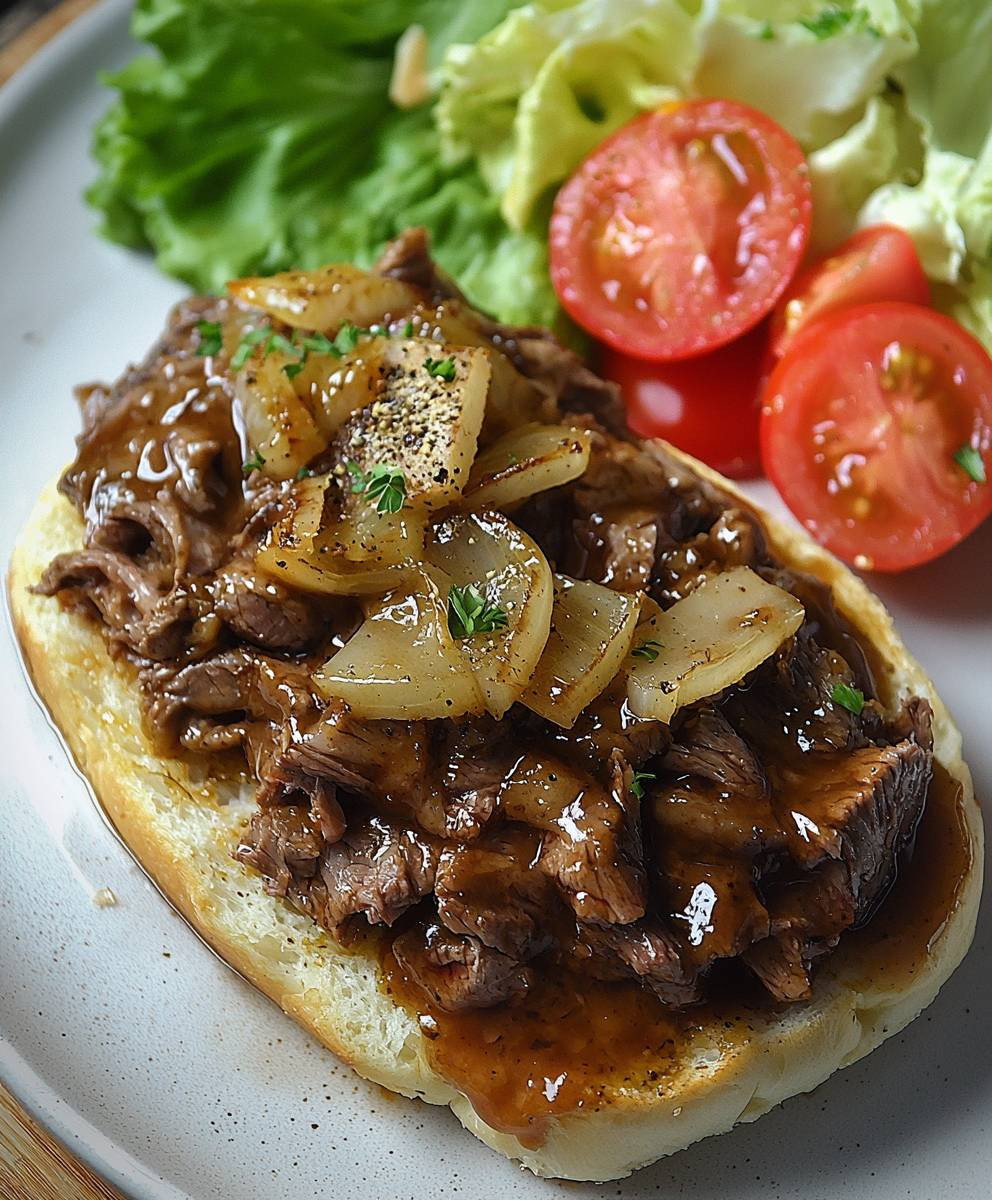
Conclusion:
This Lazy Roast Beef recipe isn’t just another roast beef recipe; it’s a game-changer for busy weeknights or relaxed weekend gatherings. I truly believe it’s a must-try because it delivers incredible flavor and tenderness with minimal effort. Forget spending hours slaving away in the kitchen this method allows you to enjoy a restaurant-quality roast beef without the restaurant price tag or the fuss. The slow cooking process ensures that the beef is incredibly juicy and practically melts in your mouth, while the simple seasoning blend enhances the natural flavors of the meat without overpowering it. But the best part? It’s incredibly versatile! Serve it sliced thin on crusty rolls with horseradish mayo and caramelized onions for an unforgettable sandwich. Or, create a hearty and satisfying meal by pairing it with roasted potatoes, glazed carrots, and a rich gravy made from the pan drippings. For a lighter option, try shredding the beef and adding it to a vibrant salad with mixed greens, crumbled blue cheese, and a tangy vinaigrette.Serving Suggestions and Variations:
* Classic Roast Beef Dinner: Serve with roasted potatoes, Yorkshire pudding, and a side of green beans. Don’t forget the gravy! * Roast Beef Sandwiches: Thinly sliced on rye bread with Swiss cheese, sauerkraut, and Russian dressing for a Reuben-inspired treat. * Roast Beef Tacos: Shredded and served in warm tortillas with your favorite taco toppings like salsa, guacamole, and sour cream. * Roast Beef Salad: Sliced or shredded over a bed of mixed greens with tomatoes, cucumbers, and a balsamic vinaigrette. * Roast Beef Stroganoff: Combine sliced roast beef with a creamy mushroom sauce and serve over egg noodles. * Spice it up: Add a pinch of red pepper flakes to the seasoning blend for a little heat. * Herb it up: Experiment with different herbs like rosemary, thyme, or oregano to customize the flavor. * Wine Pairing: A bold Cabernet Sauvignon or a smooth Merlot would be a perfect complement to this rich and flavorful roast beef. I’m so confident that you’ll love this recipe that I urge you to give it a try. It’s perfect for both novice cooks and seasoned chefs alike. The simplicity of the preparation combined with the incredible results makes it a winner every time. Once you’ve made it, I’d absolutely love to hear about your experience! Did you try any variations? What sides did you serve with it? What did your family and friends think? Share your photos and stories in the comments below! Your feedback is invaluable and helps other readers discover the joy of this incredibly easy and delicious Lazy Roast Beef recipe. I can’t wait to see what culinary creations you come up with! Happy cooking! PrintLazy Roast Beef: The Easiest & Most Delicious Recipe
Tender and flavorful chuck roast, made easy with a simple dry rub and slow-cooked to perfection. Perfect for a comforting family meal!
- Prep Time: 20 minutes
- Cook Time: 180 minutes
- Total Time: 200 minutes
- Yield: 6–8 servings 1x
Ingredients
- 3–4 lb Beef Chuck Roast
- 1 packet (1 oz) Dry Onion Soup Mix
- 1 packet (1 oz) Ranch Dressing Mix
- 1/2 cup Water
- 1 tbsp Olive Oil
- 1 tsp Garlic Powder
- 1/2 tsp Black Pepper
- Optional: Carrots, Potatoes, Celery (cut into large chunks)
Instructions
- Prepare the Roast: Take the chuck roast out of the refrigerator 30 minutes before cooking. Pat it dry with paper towels.
- Make the Seasoning: In a small bowl, combine the dry onion soup mix, ranch dressing mix, garlic powder, and black pepper.
- Season the Roast: Drizzle olive oil all over the roast and rub it in. Generously sprinkle the dry seasoning mixture all over the roast, pressing it into the meat.
- Prep Vegetables (Optional): Peel and chop carrots, potatoes, and celery into large chunks.
- Sear the Roast (Optional but Recommended): Heat a large skillet or Dutch oven over medium-high heat. Sear the roast for 3-4 minutes per side, until browned. Remove from skillet.
- Slow Cook in the Oven: Preheat oven to 325°F (160°C).
- Assemble: If using vegetables, arrange them in the bottom of a Dutch oven or roasting pan. Place the roast on top of the vegetables.
- Add Water: Pour 1/2 cup of water into the bottom of the pan.
- Cover and Cook: Cover tightly with a lid or aluminum foil. Cook for 3-4 hours, or until the roast is fork-tender. Check after 3 hours.
- Check Internal Temperature: Use a meat thermometer to ensure the roast reaches a safe internal temperature. Aim for at least 145°F (63°C) for medium-rare, 160°F (71°C) for medium, or 170°F (77°C) for well-done. For a more tender, shreddable texture, cook to around 200-205°F (93-96°C).
- Rest: Remove from oven and let the roast rest for 15-20 minutes before slicing or shredding.
- Serve: Shred or slice the roast and serve with the cooked vegetables and pan juices. Make gravy from pan juices if desired.
Notes
- Searing the roast before slow cooking adds a depth of flavor.
- Adjust cooking time based on the size of the roast and your oven.
- Resting the roast is crucial for tenderness.
- For a richer flavor, substitute 1/2 cup of the water with 1/2 cup of red wine.
- This recipe can easily be adapted for a slow cooker. Sear the roast as directed, then place it in the slow cooker with the vegetables and water. Cook on low for 8-10 hours, or on high for 4-5 hours, or until the roast is fork-tender.
- Spice it up with a pinch of red pepper flakes to the seasoning mixture for a little heat.
- Add some herbs: Fresh rosemary or thyme sprigs added to the Dutch oven or roasting pan will infuse the roast with a lovely aroma and flavor.
- Use different vegetables: Feel free to substitute other root vegetables, such as parsnips or turnips, for the carrots, potatoes, and celery.
- For even better browning, you can broil the roast for a few minutes after it’s cooked, but watch it carefully to prevent burning.

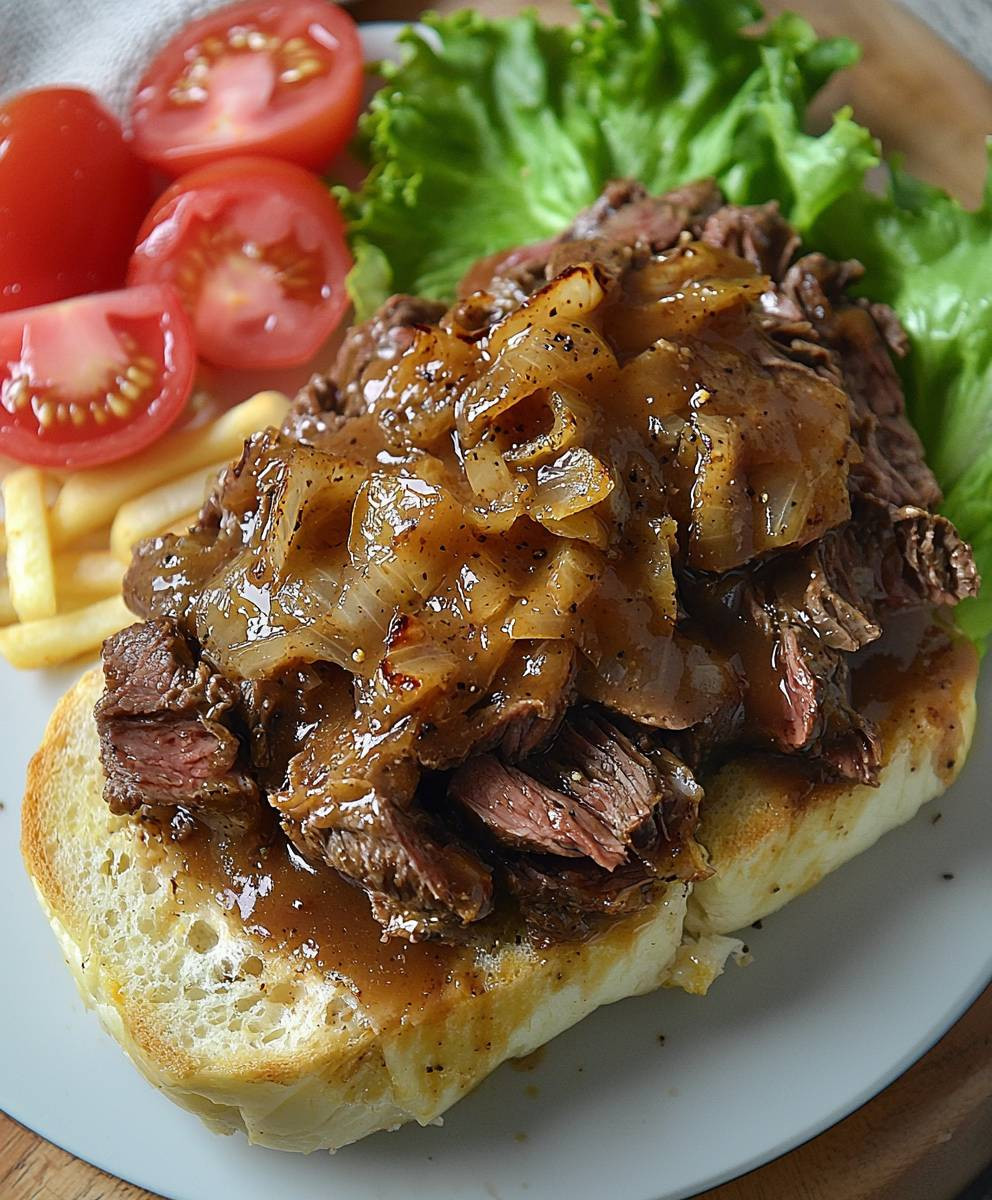
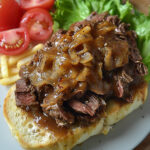

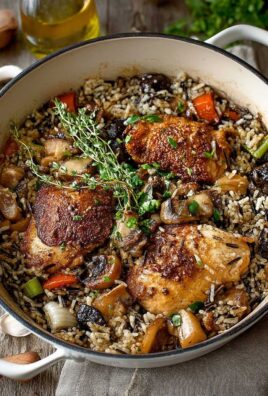
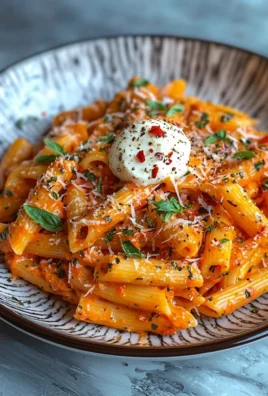
Leave a Comment